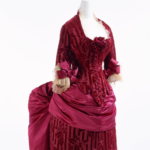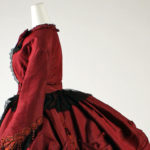1870-1879
During the 1870s, women’s clothing became increasingly complex, colorful, and restrictive, while menswear was marked by an industrious sobriety.
During the 1870s, women’s clothing became increasingly complex, colorful, and restrictive, while menswear was marked by an industrious sobriety.
The year 1938 was a period of transition from the catastrophic Great Depression to World War II. Women’s fashion was exuberant: vibrant colors, Surrealist accessories, ornate hats with minimal embellishments were key trends. However, the overall silhouette was simple, clean, and sophisticated. Hemlines began to fall down below the knees. Restrained, structured shoulders evolved into the iconic puff sleeve. Public figures such as the Duchess of Windsor inspired women in their everyday dress.
A nineteenth-century women’s hat that featured a large brim which extended beyond the wearer’s face.
Mary Cassatt’s 1880 portrait of Lydia Crocheting in the Garden at Marly features the artist’s ailing sister, Lydia Cassatt, wearing a large white bonnet and a blue day dress accented with a plaid print and white lace–a common dress style of the time.

 fez
fez 1883 – Charles Frederick Worth, red silk satin and velvet dinner dress
1883 – Charles Frederick Worth, red silk satin and velvet dinner dress The Fez and the Ottoman Path to Modernity
The Fez and the Ottoman Path to Modernity 1869 – Red Silk Dress
1869 – Red Silk Dress